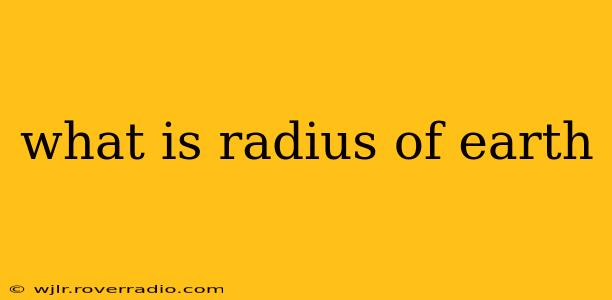The Earth isn't a perfect sphere; it's slightly flattened at the poles and bulging at the equator, a shape known as an oblate spheroid. This means there isn't one single radius. Instead, we use different radii depending on the measurement needed. Let's explore the different types and their values.
What are the different types of Earth's radius?
The Earth's radius can be measured in several ways, leading to slightly different figures:
-
Equatorial Radius: This is the distance from the Earth's center to the equator. It's the longest radius and is approximately 6,378 kilometers (3,963 miles).
-
Polar Radius: This is the distance from the Earth's center to the North or South Pole. It's shorter than the equatorial radius, measuring approximately 6,357 kilometers (3,950 miles).
-
Mean Radius: This is an average radius calculated to represent the Earth's size. It's approximately 6,371 kilometers (3,959 miles). This is often the figure cited when a single value is needed.
Why is the Earth's radius not a single number?
The Earth's shape is not perfectly spherical due to its rotation. As the Earth spins, centrifugal force pushes outwards more strongly at the equator, causing a bulge. This bulge makes the equatorial diameter larger than the polar diameter. Therefore, the radius varies depending on the location on the Earth's surface.
How is the Earth's radius measured?
Precise measurement of the Earth's radius has been a challenge throughout history. Early attempts involved sophisticated triangulation methods, measuring distances and angles to calculate the circumference and then deriving the radius. Modern techniques utilize satellite geodesy and GPS technology. These technologies allow for extremely precise measurements taking into account the Earth's irregular shape and gravitational field.
What are the implications of the Earth's shape and radius?
The slightly oblate shape of the Earth has several implications:
-
Gravitational Variations: Gravity is slightly stronger at the poles and weaker at the equator due to the Earth's shape and rotation.
-
Geographic Calculations: Accurate geographical calculations, like mapping and navigation, require considering the Earth's oblate spheroid shape rather than a perfect sphere.
-
Satellite Orbits: Satellite orbits are influenced by the Earth's irregular gravitational field, caused in part by its non-spherical shape.
How accurate are the measurements of the Earth's radius?
Modern measurements of the Earth's radius are extremely precise, thanks to advancements in satellite technology and data analysis. The values provided are generally accurate to within a few meters. Ongoing research and technological improvements continue to refine these measurements.
This information provides a comprehensive understanding of the Earth's radius, going beyond a simple numerical answer. By understanding the different types of radii and the reasons for their variations, one gains a deeper appreciation for the complexities of our planet's shape and its impact on various scientific disciplines.
